Delta 638517-00, SM300 User Manual
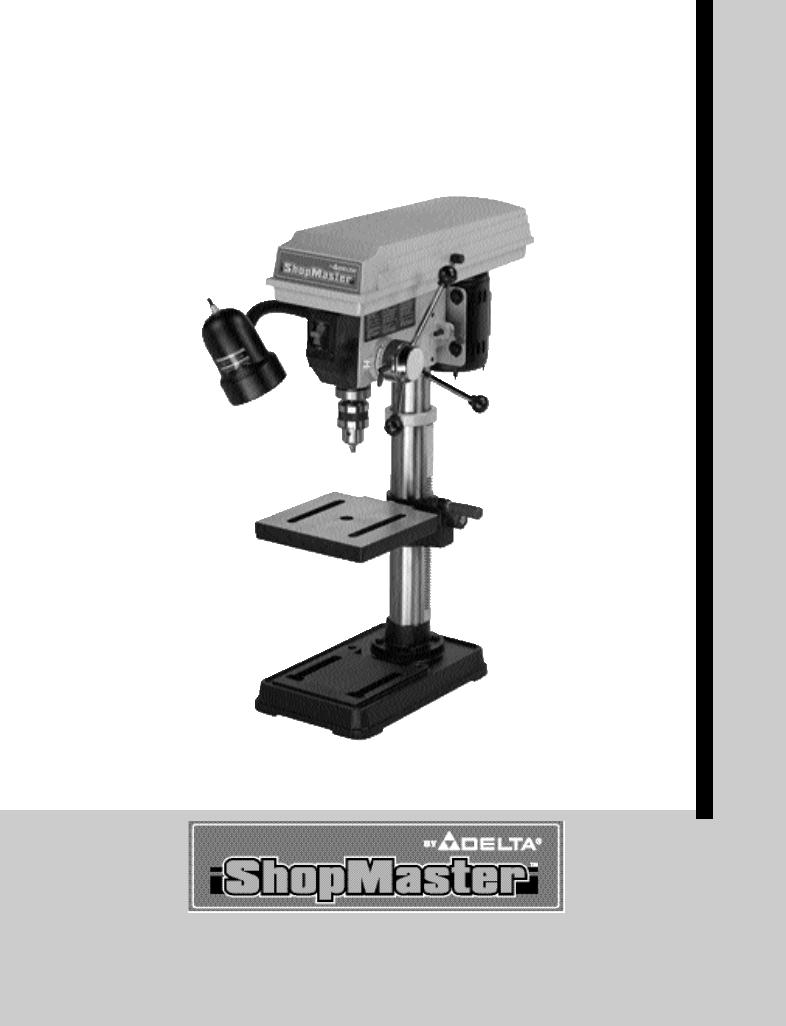
10" Bench Drill Press
(Model SM300)
PART NO. 638517-00 10-30-05
Copyright © 2005 Delta Machinery
|
|
|
|
To learn more about DELTA MACHINERY |
|
|
|
ESPAÑOL: PÁGINA 18 |
|
||
visit our website at: www.deltamachinery.com. |
|
|
|
|
|
||
|
|
|
|
For Parts, Service, Warranty or other Assistance, |
|
FRANÇAIS : PAGE 34 |
|
please call 1-800-223-7278 (In Canada call 1-800-463-3582).
GENERAL SAFETY RULES
Woodworking can be dangerous if safe and proper operating procedures are not followed. As with all machinery, there are certain hazards involved with the operation of the product. Using the machine with respect and caution will considerably lessen the possibility of personal injury. However, if normal safety precautions are overlooked or ignored, personal injury to the operator may result. Safety equipment such as guards, push sticks, hold-downs, featherboards, goggles, dust masks and hearing protection can reduce your potential for injury. But even the best guard won’t make up for poor judgment, carelessness or inattention. Always use common sense and exercise caution in the workshop. If a procedure feels dangerous, don’t try it. Figure out an alternative procedure that feels safer. REMEMBER: Yourpersonal safety is your responsibility.
This machine was designed for certain applications only. Delta Machinery strongly recommends that this machine not be modified and/or used for any application other than that for which it was designed. If you have any questions relative to a particular application, DO NOT use the machine until you have first contacted Delta to determine if it can or should be performed on the product.
Technical Service Manager - Delta Machinery
4825 Highway 45 North Jackson, TN 38305
(IN CANADA: 505 SOUTHGATE DRIVE, GUELPH, ONTARIO
N1H 6M7)
 READ AND UNDERSTAND ALL WARNINGS AND OPERATING INSTRUCTIONS BEFORE USING THIS EQUIPMENT. Failure to follow all instructions listed below, may result in electric shock, fire, and/or serious personal injury or property damage.
READ AND UNDERSTAND ALL WARNINGS AND OPERATING INSTRUCTIONS BEFORE USING THIS EQUIPMENT. Failure to follow all instructions listed below, may result in electric shock, fire, and/or serious personal injury or property damage.
1. FOR YOUR OWN SAFETY, READ INSTRUCTION MANUAL BEFORE OPERATING THE TOOL. Learn the tool’s application and limitations as well as the specific hazards peculiar to it.
2.KEEP GUARDS IN PLACE and in working order.
3.A LWAYS WEAR EYE PROTECTION. Wear safety glasses. Everyday eyeglasses only have impact resistant lenses; they are not safety glasses. Also use face or dust mask if cutting operation is dusty. These safety glasses must conform to ANSI Z87.1 requirements. NOTE: Approved glasses have Z87 printed or stamped on them.
4.REMOVE ADJUSTING KEYS AND WRENCHES.Form habit of checking to see that keys and adjusting wrenches are removed from tool before turning it “on”.
5.KEEP WORK AREA CLEAN. Cluttered areas and benches invite accidents.
6.D’TON USE IN DANGEROUS ENVIRONMENT. D’ton use power tools in damp or wet locations, or expose them to rain. Keep work area well-lighted.
7.KEEP CHILDREN AND VISITORS AWAY. All children and visitors should be kept a safe distance from work area.
8.MAKE WORKSHOP CHILDPROOF – with padlocks, master switches, or by removing starter keys.
9. DON’T FORCE TOOL. It will do the job better and be safer at the rate for which it was designed.
10.USE RIGHT TOOL. ’Dtforcen tool or attachment to do a job for which it was not designed.
11.WEAR PROPER APPAREL. No loose clothing, gloves, neckties, rings, bracelets, or other jewelry to get caught in moving parts. Nonslip footwear is recommended. Wear protective hair covering to contain long hair.
12.SECURE WORK. Use clamps or a vise to hold work when’ practical. It s safer than using your hand and frees both hands to operate tool.
13.D’TON OVERREACH. Keep proper footing and balance at all times.
14.MAINTAIN TOOLS IN TOP CONDITION. Keep tools sharp and clean for best and safest performance. Follow instructions for lubricating and changing accessories.
15.DISCONNECT TOOLS before servicing and when changing accessories such as blades, bits, cutters, etc.
16.USE RECOMMENDED ACCESSORIES. The use of accessories and attachments not recommended by Delta may cause hazards or risk of injury to persons.
17.REDUCE THE RISK OF UNINTENTIONAL STARTING. Make sure switch is in “OFF” position before plugging in power cord. In the event of a power failure, move switch to the “OFF” position.
18.NEVER STAND ON TOOL. Serious injury could occur if the tool is tipped or if the cutting tool is accidentally contacted.
19.CHECK DAMAGED PARTS. Before further use of the tool, a guard or other part that is damaged should be carefully checked to ensure that it will operate properly and perform its intended function – check for alignment of moving parts, binding of moving parts, breakage of parts, mounting, and any other conditions that may a ffect its operation. A guard or other part that is damaged should be properly repaired or replaced.
20.DIRECTION OF FEED. Feed work into a blade or cutter against the direction of rotation of the blade or cutter only.
21.NEVER LEAVE TOOL RUNNING UNATTENDED. TURN POWER OFF. Don’t leave tool until it comes to a complete stop.
22.STAY ALERT, WATCH WHAT YOU ARE DOING, AND USE COMMON SENSE WHEN OPERATING A POWER TOOL. DO NOT USE TOOL WHILE TIRED OR UNDER THE INFLUENCE OF DRUGS, ALCOHOL, OR MEDICATION. A moment of inattention while operating power tools may result in serious personal injury.
23.MAKE SURE TOOL IS DISCONNECTED FROM POWER SUPPLY while motor is being mounted, connected or reconnected.
24.THE DUST GENERATED by certain woods and wood products can be injurious to your health. Always operate machinery in well ventilated areas and provide for proper dust removal. Use wood dust collection systems whenever possible.
SAVE THESE INSTRUCTIONS.
Refer to them often and use them to instruct others.
2

ADDITIONAL SAFETY RULES FOR
FOR DRILL PRESSES
 READ AND UNDERSTAND ALL WARNINGS AND OPERATING INSTRUCTIONS BEFORE USING THIS EQUIPMENT. Failure to follow all instructions listed below, may result in electric shock, fire, and/or serious personal injury or property damage.
READ AND UNDERSTAND ALL WARNINGS AND OPERATING INSTRUCTIONS BEFORE USING THIS EQUIPMENT. Failure to follow all instructions listed below, may result in electric shock, fire, and/or serious personal injury or property damage.
1.DO NOT OPERATE THIS TOOL UNTIL it is assembled and installed according to the instructions.
2.OBTAIN ADVICE from your supervisor, instructor, or another qualified person if you are not familiar with the operation of this tool.
3.FOLLOW ALL WIRING CODES and recommended electrical connections.
4.NEVER START THE MACHINE BEFORE CLEARING THE TABLE of all objects (tools, scrap pieces, etc.).
5.NEVER START THE MACHINE with the drill bit, cutting tool, or sander against the workpiece.
6.TIGHTEN ALL LOCK HANDLES before starting the machine.
7.USE ONLY DRILL BITS, CUTTING TOOLS, SANDING DRUMS, OR OTHER ACCESSORIES that have shanks of 1/2" in diameter or less.
8.USE ONLY DRILL BITS, CUTTING TOOLS, OR SANDING DRUMS that are not damaged.
9. PROPERLY LOCK DRILL BIT, CUTTING TOOL, OR SANDING DRUM IN THE CHUCK before operating this machine.
10.USE RECOMMENDED SPEEDS for all operations.
11.AVOID AWKWARD OPERATIONS AND HAND POSITIONS where a sudden slip could cause a hand to move into the cutting tool.
12.KEEP ARMS, HANDS, AND FINGERS away from the cutting tool.
13.HOLD THE WORKPIECE FIRMLY AGAINST THE TABLE. Do not attempt to drill a workpiece that does not have a flat surface against the table. Prevent the
workpiece from rotating by clamping it to the table or by securing it against the drill press column.
14.TURN THE MACHINE “OFF” AND WAIT FOR THE DRILL BIT, CUTTING TOOL, OR SANDER TO STOP TURNING prior to cleaning the work area, removing debris, removing or securing workpiece, or changing the angle of the table. A moving drill bit, cutting tool, or sander can be dangerous.
15 PROPERLY SUPPORT LONG OR WIDE workpieces.
16.NEVER PERFORM LAYOUT, ASSEMBLY, or set-up work on the table/work area when the machine is running.
17TURN THE TOOL “OFF”, disconnect the tool from the power source before installing or removing accessories, before adjusting or changing set-ups, or when making repairs.
18.DISCONNECT THE TOOL from the power source, and clean the table/work area before leaving the tool.
LOCK THE SWITCH IN THE “OFF” POSITION to prevent unauthorized use.
19.ADDITIONAL INFORMATION regarding the safe and proper operation of this tool is available from the Power Tool Institute, 1300 Summer Avenue, Cleveland, OH 44115-2851. Information is also available from the National Safety Council, 1121 Spring Lake Drive, Itasca, IL 60143-3201. Please also refer to the American National Standards Institute ANSI 01.1 Safety Requirements for Woodworking Machines and the U.S. Department of Labor OSHA 1910.213 Regulations.
SAVE THESE INSTRUCTIONS.
Some dust created by power sanding, sawing, grinding, drilling, and other construction activities contains chemicals known to cause cancer, birth defects or other reproductive harm. Some
examples of these chemicals are:
•lead from lead-based paints,
•crystalline silica from bricks and cement and other masonry products, and
•arsenic and chromium from chemically-treated lumber (CCA).
Your risk from these exposures varies, depending on how often you do this type of work. To reduce your exposure to these chemicals: work in a well ventilated area, and work with approved safety equipment, such as those dust masks that are specially designed to filter out microscopic particles.
•Avoid prolonged contact with dust from power sanding, sawing, grinding, drilling, and other construction activities. Wear protective clothing and wash exposed areas with soap and water. Allowing dust to get into your mouth, eyes, or lay on the skin may promote absorption of harmful chemicals.
Use of this tool can generate and/or disperse dust, which may cause serious and permanent respiratory or other injury. Always use NIOSH/OSHA approved respiratory protection appropriate for the dust exposure. Direct particles away from face and body.
Wear appropriate hearing protection during use. Under some conditions and duration of use, noise from this product may contribute to hearing loss.
3

POWER CONNECTIONS
A separate electrical circuit should be used for your machines. This circuit should not be less than #12 wire and should be protected with a 20 Amp time lag fuse. If an extension cord is used, use only 3-wire extension cords which have 3- prong grounding type plugs and matching receptacle which will accept the machine’ s plug. Before connecting the machine to the power line, make sure the switch (s) is in the “OFF” position and be sure that the electric current is of the same characteristics as indicated on the machine. All line connections should make good contact. Running on low voltage will damage the machine.
 SHOCK HAZARD. DO NOT EXPOSE THE MACHINE TO RAIN OR OPERATE THE MACHINE IN DAMP LOCATIONS.
SHOCK HAZARD. DO NOT EXPOSE THE MACHINE TO RAIN OR OPERATE THE MACHINE IN DAMP LOCATIONS.
GROUNDING INSTRUCTIONS
 SHOCK HAZARD. THIS MACHINE MUST BE GROUNDED WHILE IN USE TO PROTECT THE OPERATOR FROM ELECTRIC SHOCK. Your machine is wired for 120 Volt, 60 HZ alternating current. Before connecting the machine to the power source, make sure the switch is in the “OFF” position.
SHOCK HAZARD. THIS MACHINE MUST BE GROUNDED WHILE IN USE TO PROTECT THE OPERATOR FROM ELECTRIC SHOCK. Your machine is wired for 120 Volt, 60 HZ alternating current. Before connecting the machine to the power source, make sure the switch is in the “OFF” position.
1. All grounded, cord-connected machines:
In the event of a malfunction or breakdown, grounding provides a path of least resistance for electric current to reduce the risk of electric shock. This machine is equipped with an electric cord having an equipment-grounding conductor and a grounding plug. The plug must be plugged into a matching outlet that is properly installed and grounded in accordance with all local codes and ordinances.
Do not modify the plug provided - if it will not fit the outlet, have the proper outlet installed by a qualified electrician.
Improper connection of the equipment-grounding conductor can result in risk of electric shock. The conductor with insulation having an outer surface that is green with or without yellow stripes is the equipmentgrounding conductor. If repair or replacement of the electric cord or plug is necessary, do not connect the equipment-grounding conductor to a live terminal.
Check with a qualified electrician or service personnel if the grounding instructions are not completely understood, or if in doubt as to whether the machine is properly grounded.
Use only 3-wire extension cords that have 3-prong grounding type plugs and matching 3-conductor receptacles that accept the machine’ s plug, as shown in Fig. A.
Repair or replace damaged or worn cord immediately.
GROUNDED OUTLET BOX
CURRENT
CARRYING
PRONGS
2. Grounded, cord-connected machines intended for use on a supply circuit having a nominal rating less than 150 volts:
If the machine is intended for use on a circuit that has an outlet that looks like the one illustrated in Fig. A, the machine will have a grounding plug that looks like the plug illustrated in Fig. A. A temporary adapter, which looks like the adapter illustrated in Fig. B, may be used to connect this plug to a matching 2-conductor receptacle as shown in Fig. B if a properly grounded outlet is not available. The temporary adapter should be used only until a properly grounded outlet can be installed by a qualified electrician. The green-colored rigid ear, lug, and the like, extending from the adapter must be connected to a permanent ground such as a properly grounded outlet box. Whenever the adapter is used, it must be held in place with a metal screw.
NOTE: In Canada, the use of a temporary adapter is not permitted by the Canadian Electric Code.
 SHOCK HAZARD. IN ALL CASES, MAKE CERTAIN THE RECEPTACLE IN QUESTION IS PROPERLY GROUNDED. IF YOU ARE NOT SURE HAVE A Q U A L I F I E D ELECTRICIAN CHECK THE RECEPTACLE .
SHOCK HAZARD. IN ALL CASES, MAKE CERTAIN THE RECEPTACLE IN QUESTION IS PROPERLY GROUNDED. IF YOU ARE NOT SURE HAVE A Q U A L I F I E D ELECTRICIAN CHECK THE RECEPTACLE .
GROUNDED OUTLET BOX
GROUNDING
MEANS
ADAPTER
GROUNDING BLADE |
Fig. A |
Fig. B |
IS LONGEST OF THE 3 BLADES |
4
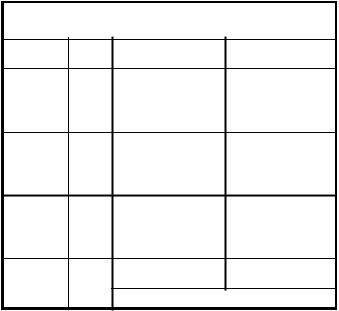
EXTENSION CORDS
Use proper extension cords. Make sure your extension cord is in good condition and is a 3-wire extension cord which has a 3-prong grounding type plug and matching receptacle which will accept the machine’ s plug. When using an extension cord, be sure to use one heavy enough to carry the current of the machine. An undersized cord will cause a drop in line voltage, resulting in loss of power and overheating. Fig. C, shows the correct gauge to use depending on the cord length. If in doubt, use the next heavier gauge. The smaller the gauge number, the heavier the cord.
Fig. C
O P E R ATING INSTRUCTIONS
F O R E W O R D
The ShopMaster Model SM300 is a 10" bench drill press with a 3.2 amp motor, and a flexible work lamp. The model SM300 can handle most types of drill press operations.
U N PACKING AND CLEANING
Carefully unpack the machine and all loose items from the shipping container(s). Remove the protective coating from all unpainted surfaces. This coating may be removed with a soft cloth moistened with kerosene (do not use acetone, gasoline or lacquer thinner for this purpose). After cleaning, cover the unpainted surfaces with a good quality household floor paste wax.
NOTICE: THE MANUAL COVER PHOTO ILLUSTRATES THE CURRENT PRODUCTION MODEL. ALL OTHER ILLUSTRATIONS ARE REPRESENTATIVE ONLY AND MAY NOT DEPICT THE ACTUAL COLOR, LABELING OR ACCESSORIES AND MAY BE INTENDED TO ILLUSTRATE TECHNIQUE ONLY.
5
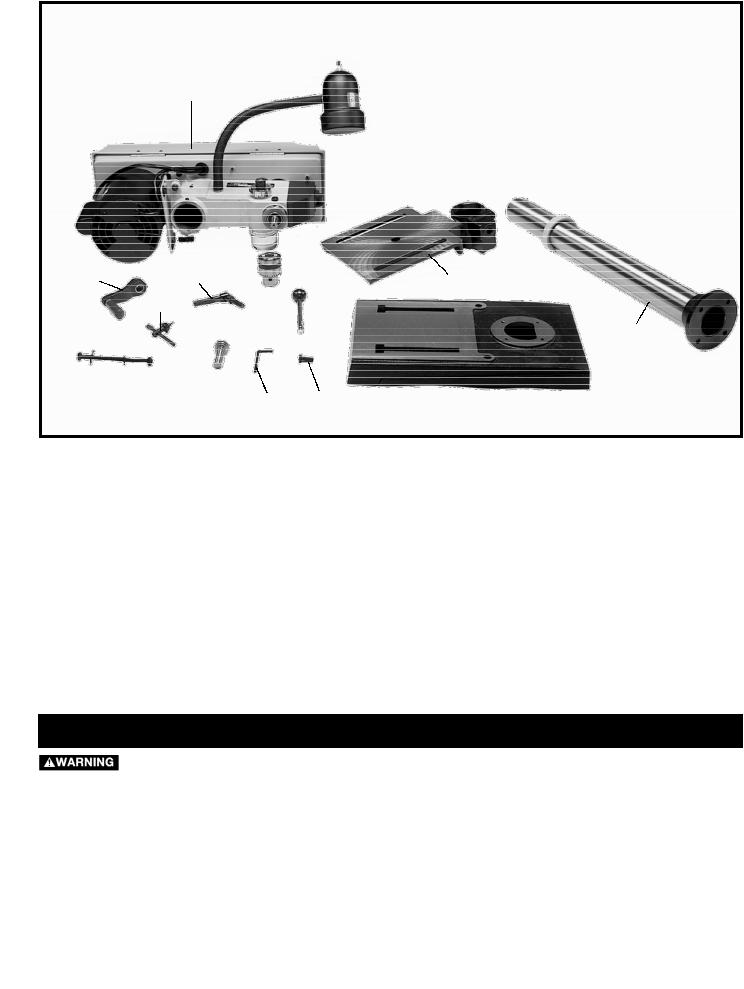
DRILL PRESS PARTS
1
|
3 |
4 |
|
|
|
|
|
|
|
|
|
||
2 |
11 |
|||||
|
5 |
6 |
|
|
||
|
|
|
||||
13
|
|
|
|
|
|
|
|
|
|
|
|
|
|
7 |
|
|
|
|
|
|
|
|
|
|
|
||
8 |
9 |
10 |
|
|||
|
|
|
||||
|
|
|
||||
|
|
|
|
|
12 |
|
Fig. 2
1 - Drill Press Head and Motor
8 - Worm Gear for Table Raising and Lowering
2 - Table Raising and Lowering Handle
9 - Allen Wrenches (2)
3 - Table Clamp
10 - M8x1.25x25mm Hex Head Cap Screws (4)
4 - Chuck
11 - Table
5 - Chuck Key
12 - Base
6 - Pinon Shaft Handles (3)
13 - Column, Base Flange and Rack
7 - M8x1.25x125mm Carriage Head Screws (2), M8 Flat
Washers (2), M8.1 Lock Washers (2), M8x1.25 Hex Nuts
(2) (for fastening the base to a supporting surface)
A S S E M B LY
For your own safety, do not connect the machine to the power source until the machine is completely assembled and you read and understand the entire instruction manual.
ASSEMBLY TOOLS REQUIRED
1.) 2 hex wrenches - supplied |
2.) soft-tip hammer |
ASSEMBLY TIME ESTIMATE
1 hour or less
6
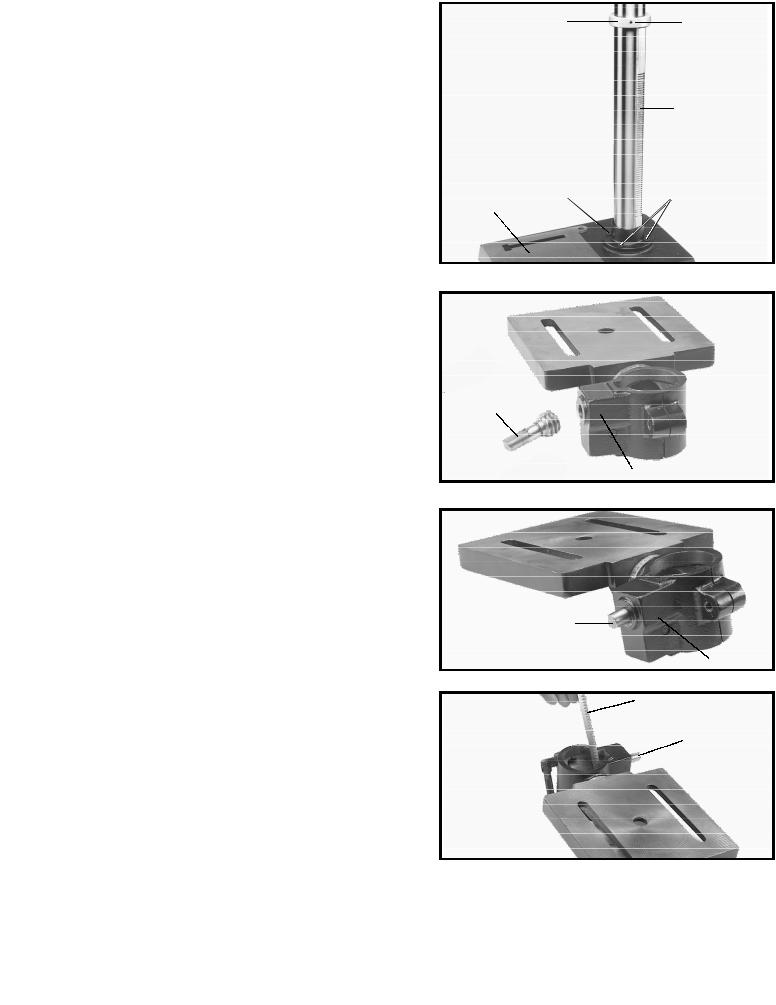
1. Assemble the column (A) Fig. 3, to the base (B) using the four screws, three of which are shown at (C). Loosen set screw (D) and remove ring (E) and raising rack (F).
2. Make certain worm gear (G) Figs. 4 and 5, is in place in table bracket (H) as shown.
3. Insert raising rack (F) Fig. 6, which was removed in STEP 1, into groove in table bracket making sure teeth of worm gear (G) located inside table bracket are engaged with teeth of raising rack (F).
E D
F
C |
A |
|
C |
|
|||
|
|
||
B |
|
|
|
Fig. 3
G
H
Fig. 4
G
H
Fig. 5
F
G
Fig. 6
7
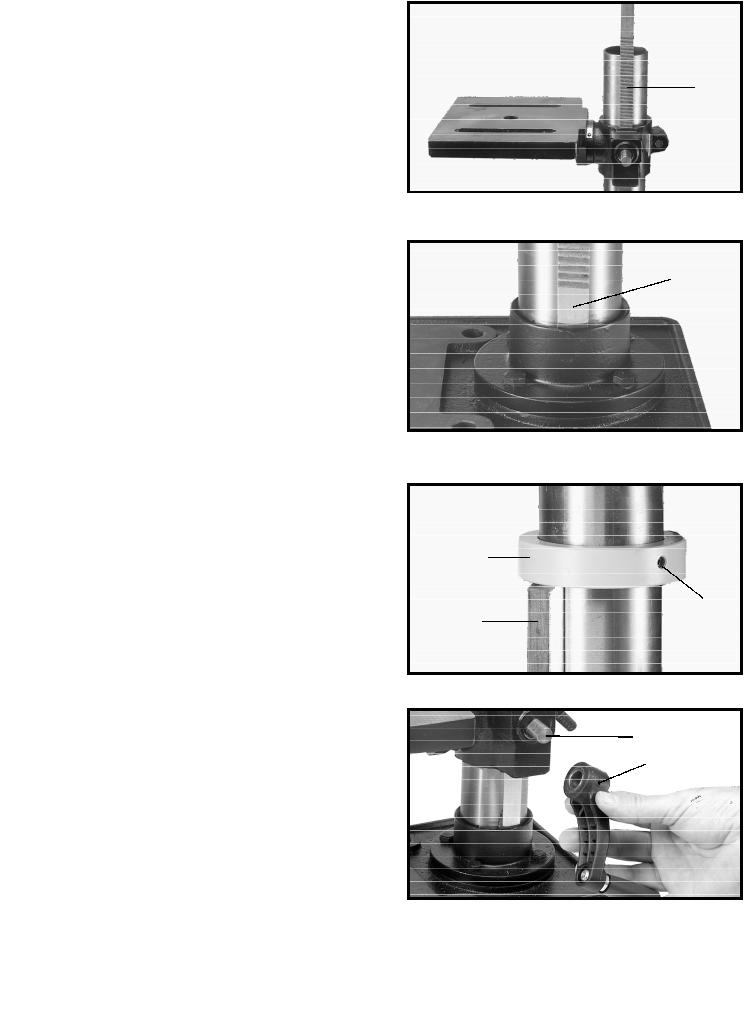
4. Slide raising rack (F) Fig. 7, table and table bracket onto drill press column, as shown. Make sure bottom of raising rack (F) Fig. 8, is inside the flange (J) on drill press base.
5. Re-assemble ring (E) Fig. 9, which was removed in
STEP 1. IMPORTANT: Bottom of ring (E) MUST NOT be pushed all the way down onto top of raising rack (F). MAKE SURE top of raising rack (F) is under bottom of ring (E) and that there is enough clearance to allow rack (F) to rotate around the column. THEN TIGHTEN SET SCREW (D)
BEING CAREFUL NOT TO OVERTIGHTEN.
6. Assemble table raising and lowering handle (K) Fig. 10, to worm gear shaft (G) and tighten screw (L) against flat on shaft.
F
Fig. 7
F
 J
J
Fig. 8
E
D
F
Fig. 9
G
L
K
Fig. 10
8

7. Thread stud on clamp handle (M) Fig. 12, into hole in rear of table bracket, as shown.
M
Fig. 12
8. Place the drill press head (N) Fig. 13, onto the column as far as it will go. Align head (A) Fig. 13A, to table (B), and base (C). Tighten the two head locking screws (O) Fig. 13, with wrench supplied.
N
O
Fig. 13
A
B
C
Fig. 13A
9. Thread the three pinion shaft handles (P) Fig. 14, into the three tapped holes located in the pinion shaft, as shown.
 P
P 
Fig. 14
9

10. IMPORTANT: Make certain the spindle taper (Q) Fig. 15, and tapered hole in chuck (R) are clean and free of any grease, lacquer or rust preventive coatings.
NOTE: Household oven cleaner can effectively remove any sub-stance from the spindle and chuck; however, carefully follow the manufacturer's safety rules concerning its use.
11.IMPORTANT: Open the chuck jaws as wide as possible by turning the chuck sleeve (S) Fig. 16.
12.Holding chuck on taper of spindle, tap with a soft tip hammer (T) or a block of wood and hammer to set chuck, as shown in Fig. 16. IMPORTANT: To avoid damage to the chuck, NEVER drive the chuck onto the spindle with a metal hammer.
Q
R 
Fig. 15
 S
S
T
Fig. 16
FASTENING DRILL PRESS TO SUPPORTING SURFACE
If during operation there is any tendency for the machine to tip over, slide or walk on the supporting surface, the machine base must be secured to the supporting surface with a M8x1.25x125mm carriage head screw, 8.5mm flat washer, 8.5mm lock washer, M8x1.25 hex nut, through the two holes (A) Fig. 17, located in the machine base.
A
Fig. 17
OPERATING CONTROLS AND ADJUSTMENTS
STARTING AND STOPPING DRILL PRESS
The switch (A) Fig. 18, is located on the front of the drill press head. To turn the drill press “ON” move the switch up to the “ON” position. To turn the drill press “OFF” move the switch down to the “OFF” position.
A
Fig. 18
10
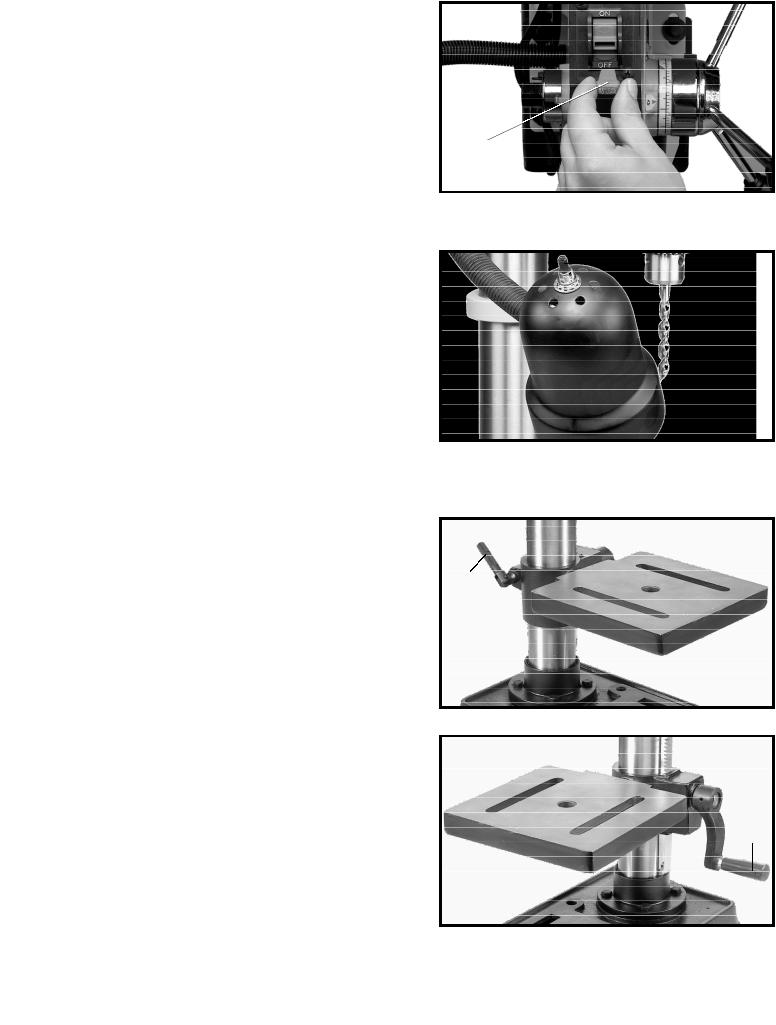
LOCKING SWITCH IN
THE “OFF” POSITION
IMPORTANT: When the machine is not in use, the switch should be locked in the “OFF” position to prevent unauthorized use. This can be done by grasping the switch toggle (B) and pulling it out of the switch, as shown in Fig. 19. With the switch toggle (B) removed, the switch will not operate. However, should the switch toggle be removed while the drill press is operating, the switch can be turned “OFF” once, but cannot be restarted without inserting the switch toggle (B).
FLEXIBLE LAMP
The flexible lamp operates independently of the drill press. To turn the lamp “ON” and “OFF”, rotate switch
(A) Fig. 19A.
 To reduce the risk of fire, use 40 watt or less, 120 volt, reflector track type light bulb (not supplied). A standard household light bulb should not be used. The reflector track type light bulb should not extend below the lamp shade.
To reduce the risk of fire, use 40 watt or less, 120 volt, reflector track type light bulb (not supplied). A standard household light bulb should not be used. The reflector track type light bulb should not extend below the lamp shade.
TABLE ADJUSTMENTS
1.The table can be raised or lowered on the drill press column by loosening the table clamp (A) Fig. 20, and turning the table raising and lowering handle (B) Fig. 21. After the table is at the desired height, tighten clamp (A) Fig. 20. NOTE: Final positioning of the drill press table should always be from the bottom to the up position.
2.The table can be rotated 360 degrees on the column by loosening clamp (A) Fig. 20, rotate table to desired position and tighten clamp (A).
B
Fig. 19
A
Fig. 19A
A
Fig. 20
B
Fig. 21
11
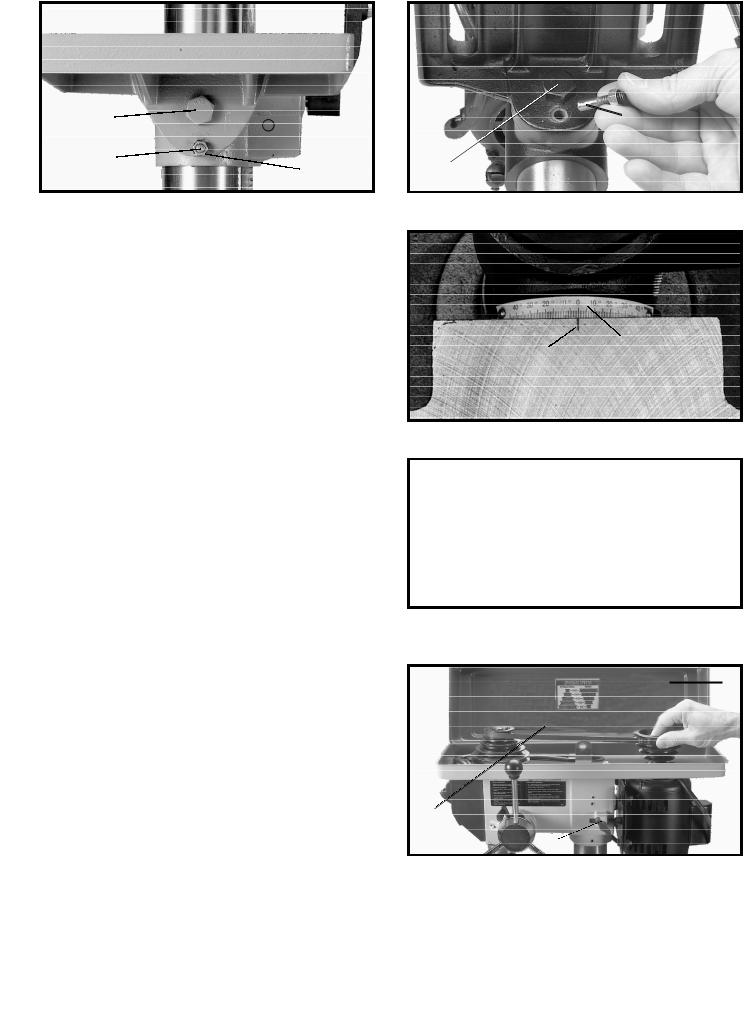
D
C
E
Fig. 22
3.The table can be tilted right or left by pulling out and removing table alignment pin (C) Fig. 22. NOTE: If pin
(C) is difficult to remove, turn nut (E) clockwise to pull pin out of casting.
4.Fig. 23, illustrates the table alignment pin (C) removed. Loosen table locking bolt (D), tilt table to the desired angle and tighten bolt (D). When returning table to the level position, replace table alignment pin (C). This will position the table surface at 90 degrees to the spindle.
5.A tilt scale (E) Fig. 24, is provided on the table bracket casting to indicate the degree of tilt. A witness line and zero mark (F) are also provided on the table to line up with the scale (E).
SPINDLE SPEEDS
Five spindle speeds of 620, 1100, 1720, 2340 and 3100 RPM are available with your drill press. Fig. 25, illustrates which step on the motor and spindle pulleys the belt must be placed on to obtain the five speeds available.
CHANGING SPEEDS AND ADJUSTING BELT TENSION
1.DISCONNECT MACHINE FROM POWER SOURCE.
2.Lift up the belt and pulley guard (A) Fig. 26.
3.Release belt tension by loosening tension lock knob
(B) Fig. 26, and pivoting the motor (D) toward the front of the drill press.
4.While holding the motor toward the front of the drill press, position the belt (C) on the desired steps of the motor and spindle pulleys, as shown in Fig. 26.
12
C
D
Fig. 23
E
F
|
Fig. 24 |
SPINDLE |
MOTOR |
3100
2340
1720
1100
620 Fig. 25
A
 D
D
C
B
Fig. 26
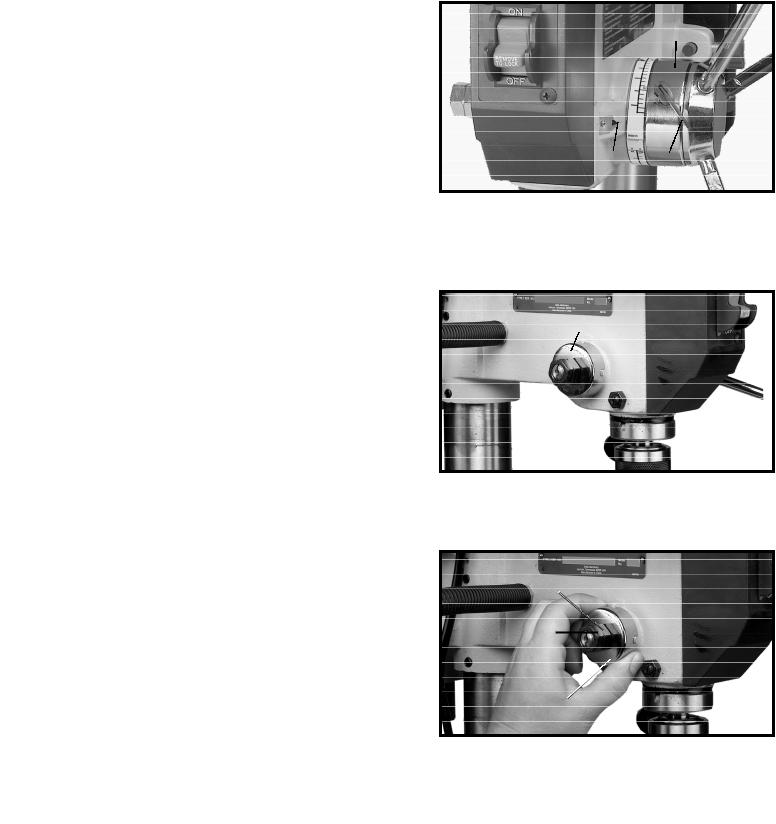
5. After the belt is positioned on the desired steps of the motor and spindle pulleys, move motor (D) Fig. 26, to the rear until the belt is properly tensioned and tighten tension lock knob (B). The belt should be just tight enough to prevent slipping. Excessive tension will reduce the life of the belt, pulleys and bearings. Correct tension is obtained when the belt (C) can be flexed about 1" out of line midway between the pulleys using light finger pressure.
DRILLING HOLES TO DEPTH
Where a number of holes are to be drilled to exactly the same depth, a depth stop is provided in the pinion shaft housing and is used as follows:
1.DISCONNECT MACHINE FROM POWER SOURCE.
2.Insert bit into chuck.
3.Lower the spindle until the pointer (C) Fig. 27, lines up with the mark on the scale (D) you wish the depth of the holes to be drilled. Then tighten lock screw (A). Return the spindle to the up position.
4.Place the material to be drilled on the drill press table. Raise the drill press table until the material to be drilled just touches the drill bit.
5.Drill a test hole to check the adjustment and readjust if necessary. All holes will then be drilled to the exact depth as indicated on scale (D) Fig. 27. NOTE: Scale (D) is calibrated in both inches and millimeters.
ADJUSTING SPINDLE
RETURN SPRING
The spindle is automatically returned to its upper most position when the handle is released. It is recommended that the handle be allowed to slowly return to the top position after each hole has been drilled in the material. This spring has been properly adjusted at the factory and should not be disturbed unless absolutely necessary. To adjust the return spring, proceed as follows:
1. DISCONNECT MACHINE FROM POWER SOURCE.
2. Loosen nuts (B) and (E) Fig. 28. Make sure spring housing (A) stays engaged with head casting.
3. While FIRMLY HOLDING spring housing (A) Fig. 29 pull out housing and rotate it until boss (D) is engaged with the next notch on the housing. Turn the housing counterclockwise to increase or clockwise to decrease spring tension. Turn nut (E) until it contacts spring housing (A), then back nut (E) out a 1/4 turn from spring housing (A). Tighten nut (B) against nut (E), to hold the housing in place. IMPORTANT: Inside nut (E) should not contact spring housing (A) when tightened.
B
D
C A
Fig. 27
A
B
 E
E
Fig. 28
E  D
D
B
A
Fig. 29
13
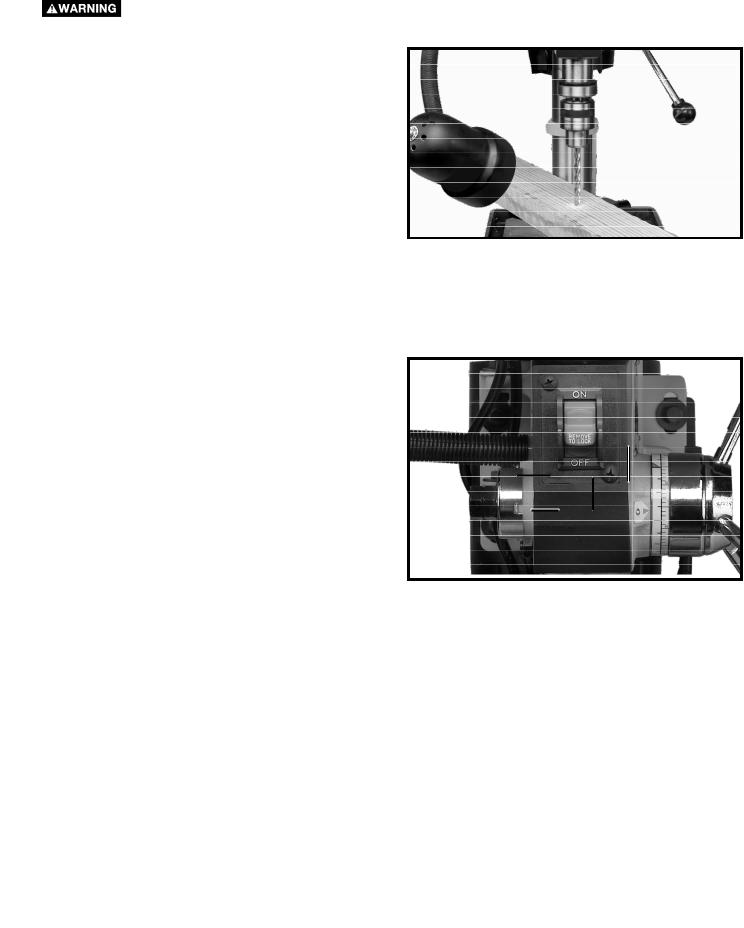
OPERATION
Your drill press is to be used with drill bits with a shank of 1/2" or less in diameter. The following will give the inexperienced operator a start on common drill press operations. Use scrap material for practice to get a feel of the machine before attempting regular work.
The use of accessories and attachments not recommended by Delta may result in risk of injury.
IMPORTANT: When the workpiece is long enough it should always be positioned on the table with one end against the left side of the column, as shown in Fig. 30. This prevents the workpiece from rotating with the drill bit or cutting tool, causing damage to the workpiece or personal injury to the operator. If it is not possible to support the workpiece against the column, the workpiece should always be fastened to the table using clamps or a vise.
Fig. 30
INSTALLING AND REMOVING DRILL BITS
1.DISCONNECT MACHINE FROM POWER SOURCE.
2.Insert smooth end of drill bit (A) Fig. 31, into chuck (B), as far as it will go, and then back the bit out 1/16", or up to the flutes for small bits.
3.Make certain that the drill bit (A) Fig. 31, is centered in the chuck (B) before tightening the chuck with the key (C).
4.Turn the chuck key (C) Fig. 31, clockwise to tighten and counterclockwise to loosen the chuck jaws.
5.Tighten all three chuck jaws to secure the drill bit sufficiently so that it does not slip while drilling.
6.MAKE SURE chuck key (C) Fig. 31, is removed from chuck before starting drill press. Your chuck key (C) is equipped with a self-ejecting pin (D) which helps minimize the hazard of the key being left in the chuck.
C
B
A D
Fig. 31
14

TROUBLESHOOTING
CORRECT DRILLING SPEEDS
Factors which determine the best speed to use are: kind of material being worked, size of hole, type of drill or other cutter, and quality of cut desired.
Use the recommended speed for the drill press bit and workpiece material.
BORING IN WOOD
Twist drills, although intended for metal drilling, may also be used for boring holes in wood. However, machine spur bits are generally preferred for working in wood; they cut a flat bottom hole and are designed for removal of wood chips. Do not use hand bits which have a screw tip; at drill press speeds they turn into the wood so rapidly as to lift the work off the table and whirl it.
For through boring, line up the table so that the bit will enter the center hole to avoid damage to the table. Scribe a vertical line on the front of the column and a matching mark on the table bracket and the drill press head, so that the table and drill press head can be clamped in the center position at any height.
Feed slowly when the bit is about to cut through the wood to prevent splintering the bottom face. Use a scrap piece of wood as a base block under the work; this helps to reduce splintering and protects the point of the bit.
DRILLING METAL
Use clamps to hold the work when drilling metal. The work should never be held in the bare hand; the drill bit may seize the work at any time, especially when breaking through the stock. If the piece is whirled out of the operator's hand, the operator may be injured. The drill bit will be broken if the work strikes the column.
The work must be clamped firmly while drilling; any tilting, twisting or shifting results not only in a rough hole, but also increases drill bit breakage. For flat work, lay the piece on a wooden base and clamp it firmly down against the table to prevent it from turning. If the piece is of irregular shape and cannot be laid flat on the table, it should be securely blocked and clamped.
15
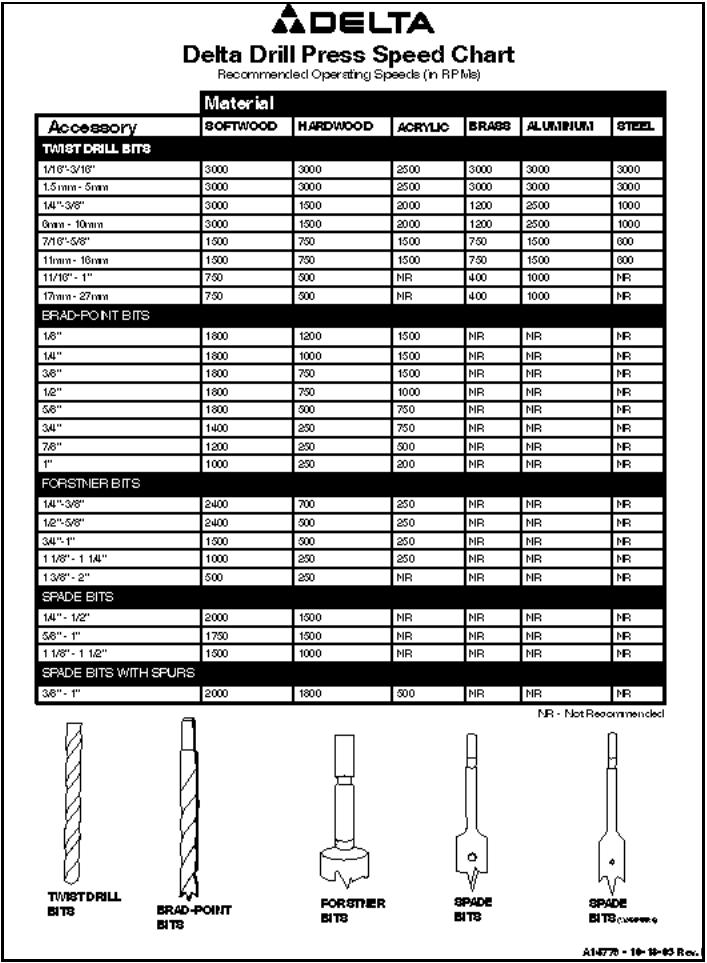
16
